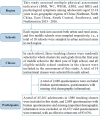A comparative study of multiple physical assessment indicators to identify psychological symptoms: a cross-sectional study based on Chinese adolescents
- PMID: 40104821
- PMCID: PMC11913707
- DOI: 10.3389/fnut.2025.1511639
A comparative study of multiple physical assessment indicators to identify psychological symptoms: a cross-sectional study based on Chinese adolescents
Abstract
Background: Body mass index (BMI), waist circumference (WC), and waist-to-height ratio (WHtR) have long been important physical assessment indicators. In recent years a body shape index (ABSI) and body roundness index (BRI) have gained importance as new physical assessment indicators. However, it is unclear how these physical assessment indicators assess psychological symptoms in adolescents. The main purpose of this study was to determine the ability of BMI, WC, WHtR, ABSI, and BRI indicators to recognize psychological symptoms in Chinese adolescents and to examine whether ABSI and BRI are superior to the traditional BMI, WC, and WHtR.
Methods: In this study, 42,472 (boys, 21,026, 49.5%) adolescents aged 12-18 years from six geographic regions in China were assessed for multiple physical assessment indicators (BMI, WC, WHtR, ABSI, BRI) and psychological symptoms from 2015 to 2016. One-way analysis of variance, Spearman's rank test, multifactor logistic regression analysis, and ROC analysis were used to analyze the validity of multiple physical assessment indicators to identify psychological symptoms.
Results: The prevalence of psychological symptoms among Chinese adolescents aged 12-18 years was 26.17%. The BMI, WC, WHtR, ABSI, and BRI of the adolescents were (20.19 ± 3.43) kg/m2, (69.68 ± 10.05) cm, (0.42 ± 0.06), (0.06 ± 0.01), and (2.05 ± 0.92), respectively. The results of Spearman's rank test showed a positive correlation (p < 0.001) between BMI, WC, WHtR, and BRI were positively associated with psychological symptoms (p < 0.001). The highest Spearman correlation coefficient was found between WC and psychological symptoms (r = 0.134, p < 0.001), and BMI was the lowest (r = 0.108, p < 0.001). Overall, the prevalence of psychological symptoms for all five physical assessment indicators (BMI, WC, WHtR, ABSI, and BRI) showed an increasing trend from Q1 to Q4 (p < 0.001). Overall, WC (AUC: 0.61, 95%CI: 0.61-0.62), WHtR (AUC: 0.61, 95%CI: 0.60-0.61), and BRI (AUC: 0.61, 95%CI: 0.60-0.61) were highly and identically predictive of psychological symptoms; ABSI was the least predictive of psychological symptoms (AUC: 0.51, 95%CI: 0.50 ~ 0.51).
Conclusion: This study found that neither the ABSI nor the BRI was superior to BMI, WC, or WHtR in predicting psychological symptoms in Chinese adolescents. The ABSI was the least predictive of psychological symptoms in Chinese adolescents, whereas the BRI showed potential as a surrogate for WC and WHtR indicators for assessing psychological symptoms. This study provides additional help and suggestions for better identification of psychological symptoms in Chinese adolescents.
Keywords: adolescents; body roundness index; cross-sectional study; physical assessment; psychological symptoms.
Copyright © 2025 Bi, Ran, Zhang, Liu, Li, Niu and Yang.
Conflict of interest statement
The authors declare that the research was conducted in the absence of any commercial or financial relationships that could be construed as a potential conflict of interest.
Figures


Similar articles
-
A body shape index and body roundness index: two new body indices to identify diabetes mellitus among rural populations in northeast China.BMC Public Health. 2015 Aug 19;15:794. doi: 10.1186/s12889-015-2150-2. BMC Public Health. 2015. PMID: 26286520 Free PMC article.
-
Predicting value of five anthropometric measures in metabolic syndrome among Jiangsu Province, China.BMC Public Health. 2020 Aug 31;20(1):1317. doi: 10.1186/s12889-020-09423-9. BMC Public Health. 2020. PMID: 32867710 Free PMC article.
-
Weight-to-height ratio and body roundness index are superior indicators to assess cardio-metabolic risks in Chinese children and adolescents: compared with body mass index and a body shape index.Transl Pediatr. 2022 Mar;11(3):318-329. doi: 10.21037/tp-21-479. Transl Pediatr. 2022. PMID: 35378962 Free PMC article.
-
Effectiveness of Body Roundness Index (BRI) and a Body Shape Index (ABSI) in Predicting Hypertension: A Systematic Review and Meta-Analysis of Observational Studies.Int J Environ Res Public Health. 2021 Nov 4;18(21):11607. doi: 10.3390/ijerph182111607. Int J Environ Res Public Health. 2021. PMID: 34770120 Free PMC article.
-
Effectiveness of body roundness index in predicting metabolic syndrome: A systematic review and meta-analysis.Obes Rev. 2020 Jul;21(7):e13023. doi: 10.1111/obr.13023. Epub 2020 Apr 8. Obes Rev. 2020. PMID: 32267621
Cited by
-
The association between sugar-sweetened beverage consumption, muscle strength, and psychological symptoms among Chinese adolescents: a multicenter cross-sectional survey.Front Nutr. 2025 Jul 31;12:1641108. doi: 10.3389/fnut.2025.1641108. eCollection 2025. Front Nutr. 2025. PMID: 40823024 Free PMC article.
References
-
- Vos T, Flaxman AD, Naghavi M, Lozano R, Michaud C, Ezzati M, et al. . Years lived with disability (ylds) for 1160 sequelae of 289 diseases and injuries 1990-2010: a systematic analysis for the global burden of disease study 2010. Lancet. (2012) 380:2163–96. doi: 10.1016/S0140-6736(12)61729-2, PMID: - DOI - PMC - PubMed
LinkOut - more resources
Full Text Sources

